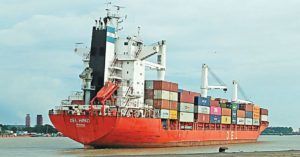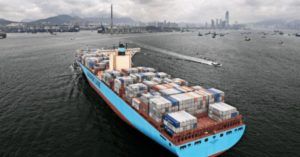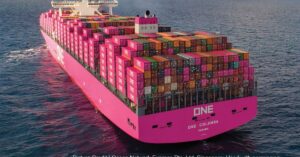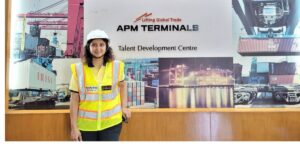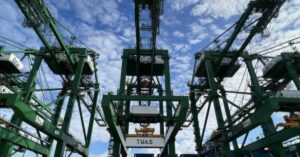You have a very impressive profile and background into finance, venture capitalism, predictive models. So, first can you give me an insight into what exactly is Freightwalla and how does it operate?
Freightwalla is basically a digital freight forwarding company. We bring in technology enablement throughout the life cycle of the freight forwarding process. For example, if you are an exporter and you are looking to understand the different route options available to you for let’s say your factory in Maharashtra to your buyer’s warehouse in let’s say the UK, we bring in technology that will allow you to search and compare all the different route options across the multiple different shipping lines with different transporters and their different price levels and different service levels, get an understanding of all of the transit lines, schedules, cut offs, etc. everything, all the relevant information that’s required to actually make a decision in terms of moving your cargo is available in a few clicks, but this is actually like a booking platform but Freightwalla is much beyond that. I mean that is only the start of our engagement with the clients. So, as an end-to-end digital freight forwarder, what we also do is that after the client books with us, we actually get heavily involved using technology in the freight forwarding process itself. So, what I am really talking about is basically the two main work streams, which is managing and stacking the physical movement of cargo as well as managing and tracking the documentation requirements required actually to ship the cargo across borders. So, our technology and systems guide both of those processes and ensure that every step is completed in time and accurately and so what we are able to do is effectively ensure that there is real on-time delivery of cargo at a much higher degree of reliability than you would get from providers who have a very manually driven process. So, essentially what we are able to do then offer the clients a higher degree of on-time reliability, a low overall cost of logistics. The technology helps ensure that there are no manual errors in the process and so, it drives the entire thing forward.
Okay. That’s a lot on the digital platform. I have several questions based on that. One is, how different it is from the conventional freight forwarding because digital platform is something….usually conventional freight forwarding gives us lot of confidence and trust that I can talk to physical people and I know that if there is a problem then there is somebody dependable. So, how does digital platform give that kind of confidence to the shipper?
So, let me put it very categorically that we do not intend for the technology to substitute the human element of freight forwarding. When we talk about digital freight forwarding and the efficiencies that can come from technology, we are mostly talking about bringing in efficiencies in the processing of documents, the information flow, information management, all of that is driven by technology but we are well cognizant of the fact that the human element in freight forwarding is very real and very important to clients and all stakeholders honestly in the process, and so what we see ourselves doing with the technology is actually using the technology to enable the relationship building so the technology is physically used as a way to build establish confidence between ourselves and various stakeholders because once the stakeholders see the sophistication of the workflow management and the packing and all of the technology that we built, they truly begin to trust that okay, if I give my requirements to this company, I know that they are going to do a good job of handling my cargo and so that really aids the relationship building that we have with the clients and of course, we are still here to provide solutions. We are not just here as a sort of a DIY platform, Do It Yourself platform, and that manner so we marry the human element with technology element to actually give a much higher degree of confidence to the clients.
Fine. Okay. There are a couple of things in what you mentioned. One is giving them the real time visibility to the container movement. There is always…most important thing is pricing part of it also. So, does this platform give the realistic pricing or costs involved because in our industry, it is very essential to know the real pricing because there is a perception that lot of hidden costs are involved. So, how does this platform work if somebody wants to have the realistic cost for him to move one container from place A to B?
Yeah. So, the prices that we have on the platform are 100% reliable and realistic. So, we actually 4 years ago when we were starting off the company; we spent a lot of time and effort to map out the way that the quotation is built for the clients and so, I think we spent almost 6 months’ time to really perfect the creation of an accurate quotation with all of the different permutations and combinations like factory stuffing, ICD pickup, hazardous cargo and non-hazardous cargo etc. So, we mapped it all out and now it is built into the system and so when you go into the system and when you actually want to move your cargo, so we won’t just provide like a high-level freight rate as you pointed out. We provide every single breakup of all of the line items involved including all of your local charges, other incidentals if they are which, you know, the system can easily identify. So, in that sense it is a very accurate and realistic cost estimate that you get out of the platform. But once again, I want to draw your attention to the fact that …prices, of course are very important. I am absolutely not taking away from it. But what we are really positioning ourselves in front of our clients is not …we are not very price oriented. So, when we approach the clients, we are honestly looking to service clients who want a higher or a next generation logistics company who can handle things in a different way. So, accurate and realistic prices are available but we find that it is not the be all and end all in case you are not able to be 100% accurate in terms of the pricing available on the platform. It is not something that overly concerns us and as I mentioned, we are not trying to be a booking platform, we are trying to be a digital forwarder. So, in that sense, there is a little bit of back and forth sometimes required with the clients and we are very happy to engage in that.
That brings me to another interesting question on the real-time tracking. So. today we are facing several challenges, especially in this pandemic era, you have shortage of equipment, disruption of services, there are some cancellation of sailings, blank sailings and there could be some custom delays in addition to these. So, how do you ensure that the customer is aware of all of these delays, challenges and disruptions? Second thing is how do you handle these and convey it to them?
So, the majority of the information flow is handled by our technology as I mentioned. So, we have connected with various stakeholders to get very accurate information on what is happening with the cargo and what is the expected timeline of deliveries. So, all of this has been built in and so managing that information flow is something that is done by our technology itself. That information flows directly to the client as it becomes available to us and that really leaves our team to be problem solvers for the client really. So once this information flow is made available to them, it is simultaneously made available to the client as well and then immediately instead of trying to as would happen typically let’s say 10 years ago, 5 years ago, you would spend a lot of time figuring out where the cargo is and what the current state is. That is no longer an action that takes up a lot of bandwidth for either us or our clients. So, we are immediately on the problem-solving mode. Once we know what is happening with the cargo, exception management is very important. That is also the key aspect of the human element of this business and so we basically work with the clients once exceptions are found out to figure out what is best option for them as on a given date. We all know that sometimes deliveries aren’t very urgent. It is not that every single shipment is urgent. So, once we interface with the client and understand what exactly is their requirement for that particular shipment on that given date, we then start working on options to mitigate challenges that can come out of it.
You said that you are not a booking platform, you are a digital freight forwarder. There are a lot of digital platforms or booking platforms today available in the marketplace. So, how does the shipper choose either of these and how is the competition for you from other platforms or digital forwarders?
So, what I would say about us compared to the booking platforms is, you know when you look at the importers and exporters available in India, you will actually see, as a forwarder you see a range of different requirements. Some people have requirement ABC, other people have requirement XYZ, and your best chance of closing the business is to really understand the requirements and the problems and go in with a quality solution and if you are able to do that, then you might actually find that maybe forwarding is not so price sensitive. Maybe clients actually care about solutioning and not just the price. So, that is the approach we are taking. We are very particular on the clients we approach. We know exactly who is the type of person who is going to be amenable to our type of service and we focus on them. We are not trying to be everything for everyone and so that is how we hold our ground and stand on our feet. When it comes to your booking performance since you know they are essentially connecting A to B on the demand and supply side respectively, I personally feel that the value addition component is lesser. The only thing you are offering is discovery and so when your value addition component is much lesser, the chance for minimization, the chance for optimisation and expanded margins is also lesser and so you come down to a few simple… you get tagged in the eyes of the client in a few simple ways. When you get tagged as that of course, there is still market for you, but then you will attract both types of clientele, the ones who want solutions will attract a different type of freight forwarding company and there may be other requirements of different types of clients and there might be a different type of logistic company that is best suited for them and so really what I, to give you a short answer to this question, I think there is scope for everyone. It is only one when you get very particular in terms of detailing what is your value proposition then you can also find a perfect client for yourself and build a sustainable business that also can stand on its own against the whole lot of competition.
You mentioned about market. So how is the adoption from market or the response from shippers to use digital platforms or freight forwarding? What exactly is your market? Is it large customers or small and medium customers or individual customers? Who are easily convertible to the digital freight forwarding system and how is it?
So, you asked about the market. So, let me just say that the market, over the last four years, has been increasing at a very strong pace and what I really mean by market increasing at a strong pace is customer adoption and customer willingness to try digital solutions. When we started the company, this was about 4 years ago roughly, it was challenging to convince a client to come online and take advantage of all the different digital tools we have partly because the perception was that this industry is not amenable to it, at least that was the thought 4 years ago. Over the course of the four years, the perception has changed drastically and even pre-Covid, I would have said that there has been a big change but post-Covid and post-lockdown, it has been a step change in terms of willingness of clients to adopt technology driven solutions. Just to give you a short example, we used to get, let’s say X amount of clients who are coming to us every month, inbound funnel, and as a logistics company you are very happy to have clients supporting you as opposed to you going out for business. Let’s say we had X number of clients pre-Covid lockdown, post-lockdown it has gone up to 10x, literally it has been a 10-fold increase so there has been a great change and I anticipate that it will only increase in time as the business models become more matured, more sophisticated and as the value propositions of each of the different models begins to evolve. Large parts of the market will begin to be amenable to it. Now, in terms of your question of whether it is large, medium or small clients who are amenable, honestly my answer is all of them but you need to be sure on what it is you are providing to them. So, your enterprise clients might be more interested in software-only offerings. Let’s say you are Fortune 500 type companies; they will be more interested in software-only offerings. Then your mid-sized companies may be more interested in solution-based offerings or digital freight forwarding or maybe depending on the sophistication, they might be interested in software-only, and then for different parts of the market, you might have a different ideal fit.
Okay. You come from the conventional freight forwarding stable. Did you cut your teeth there? And going forward, do you see, the traditional freight forwarding model diminishing and more digital freight forwarding happening?
Your question on whether I came from the traditional freight forwarding, yes and no is the answer. My primary work experience has been in strategy consulting and investments. But yes, I have enough of time in traditional forwarding as well. I think you are well aware of my family business as well. I have spent enough of time to be able to marry both schools of thought, to just put it in a nutshell. I am actually more interested in the second question you asked which is that do we see traditional freight forwarding continuing into the future. Yes. I mean traditional forwarding in 10 years’ time will be digital forwarding, so everyone will pick up different parts of the technology spectrum to improve their service levels to the client. If you are going to simply say that no, none of this is required, then there is probably going to be less and less market for you as the next 10 years come around, but not to say that the market is going to drastically change by next year or the year after that. Everyone has a chance to pick up the new solutions. It will take let’s say anywhere between 4 to 7 years for this transition period to be complete, and traditional forwarding honestly when you mention it, for me what comes to my mind is solutions-based logistics company where the interaction with the client basically is to understand what is the requirement and the requirement changes every day. Sometimes, the cargo is very urgent and you know, you are not so worried about prices, sometimes it is not so urgent and you are willing to expand the transit time to lower the cost and that is where I see the interaction with the client as being key and that understanding on a daily basis what is and then working it out with the client to figure out if this is right option for you today. That I don’t see going away at all. With technology you can make it easier for you and the client to navigate through the universe of logistics but devising solutions itself is not going anywhere.
After 4 years of existence into the operations in the market, so what is on your plate now and what are your future plans for the company? The future plan for the company is basically to just expand our offerings. So, we have been primarily west India focused. Not to say that we don’t have clients or don’t do business with the other sectors in India, being North, South, East, West. But yes, we want to expand our presence in these areas, to expand our offerings to different parts of India.



